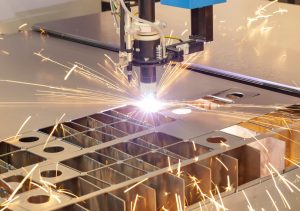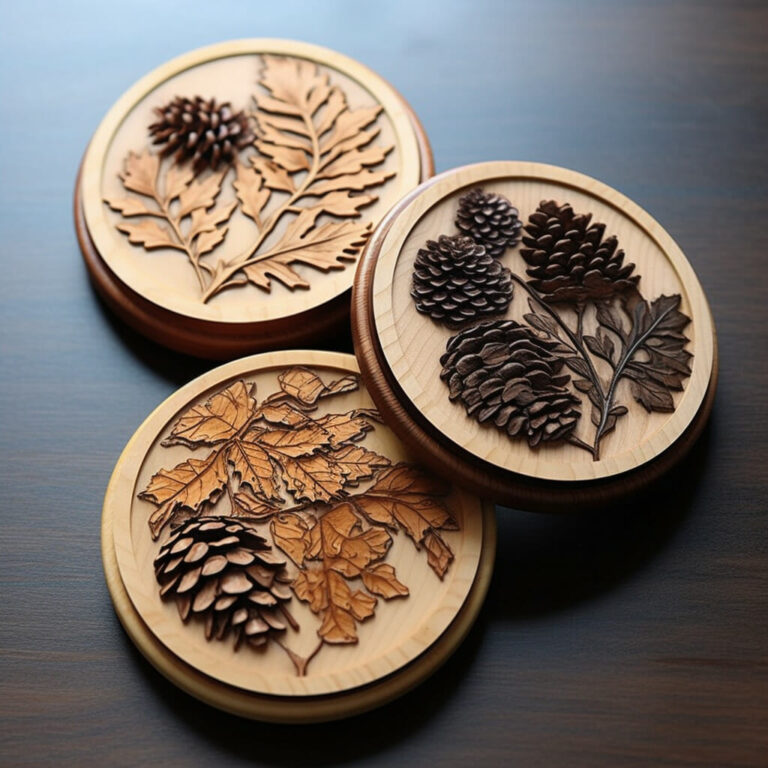The two main processes manufacturers use when they’re cutting materials like metal or wood are water jet cutting and laser cutting. Depending on the type of material you’re using and the desired end product, one of the two is usually better. However, overall, there are more benefits to owning a laser cutting machine compared to a water jet cutting machine. Read on to find out more about water jet vs laser cutting and discover what makes laser cutters superior.
What Is Laser Cutting?
Laser cutters use a gas-powered laser for energy — usually CO2. The CO2 is transmitted via a laser beam that’s guided by mirrors to cut, engrave or etch a wide variety of materials. With a CO2 laser, its source is located within the machine and the beam tends to output between 4 and 6000 watts. Applications and materials, in addition to safety and precision, are crucial factors to consider when thinking about buying a new laser cutter.
Safety and Precision
Precision is the area in which laser cutting machines stand out head and shoulders above water jet cutters. The minimum size of a cut is 0.006 inches, although this varies depending on the laser’s speed. That said, thin materials might suffer from the pressure of the gas if it’s not possible to maintain the correct distance. When gas pressure occurs, there’s a risk of partial burning — but a well-designed laser cutter should mitigate this issue.While safety goggles aren’t always necessary with a laser cutting tool, it can produce dust and smoke. Additionally, some metals and plastics might emit toxic fumes, so ventilation is essential. The overall risk of using this type of machine is extremely low, as is the amount of waste it produces and the resulting cleanup.
What Is Water Jet Cutting?
On the other side of the coin are water jet cutting machines, which use pressurized water to cut through materials. They use abrasives such as aluminum oxide and garnet to increase the cutting ability. This process replicates the erosion that carves out riverbeds and cliffs in nature. However, this type of machine uses a much higher concentration and speed, with a high-pressure pump driving the liquid through rigid holes. This results in a massively powerful jet, usually with an output of around 4 to 7 kilowatts. Whereas the laser source is within the machine with a laser cutting machine, the pump is often separate from the work area with a water jet cutter. As such, it takes up more space than a CO2 laser machine.
Safety and Precision
Precision is lacking in water jet cutting compared to laser cutting, with a minimum cut size of around 0.02 inches. Due to the extreme level of force, you need to handle small or thin parts with the utmost caution. Although burning or thermal stress aren’t an issue, the surface of the material will have the appearance of having been sandblasted. You must wear goggles to protect the face and eyes when using this type of machine to prevent the abrasive materials causing injury. Water jet cutting is also much noisier than laser cutting, and you’ll need to perform an extensive cleanup after each use. The mixed water and abrasive cause a significant amount of waste.
Laser Cutting vs Water Jet Cutting
Laser cutting and water jet cutting are the most affordable techniques to directly create a 3D object from a 2D image. They both work well with production or rapid prototyping. Let’s take a comparative look at the two techniques and see how they measure up.
Which Operations Can a Laser Cutter and a Water Jet Cutter Perform?
One of the main advantages of a laser cutting machine is that it lets you engrave and etch in addition to cutting. That means you can perform tasks such as adding assembly marks, serial numbers or aesthetic designs. On the other hand, water jet cutters partially allow 3D material cutting (although they’re not designed for it), whereas this isn’t at all possible with a laser cutter. It’s not a good idea to use materials that are made from two or more different substrates with either machine. If the two materials have different melting points, a CO2 laser cutter will struggle. Likewise, there’s a risk of delamination with a water jet cutter. So, while neither tool is designed to cut thick materials, a laser cutter can perform etching and engraving in addition to cutting.
Tooling Operating Costs
Laser engraving machines tend to be much more affordable than water jet cutters. They’re available at prices pretty much anyone looking to start up a business with low overheads and plenty of production options can afford. Water jet cutters are significantly more expensive and take up more space, which makes it harder for a small to medium-sized business owner to find the space and the funding to get off the ground.
Which Materials Can the Two Cutting Machines Cut?
Water jet and laser cutters both have the capability to cut materials you might think would be a challenge. While you can cut pretty much any material you can think of with a water jet cutter, including substrates up to 2 inches thick, there are some limits with a laser cutter. Laser cutting still cuts a broad range of materials, including most plastic, acrylic, leather, and wood. However, it will not cut metal (at least at the wattage machines we sell at Thunder Laser USA). You can permanently mark metal with a special metal marking spray. You can also etch glass, granite, and slate.
How Precise Is the Laser Cutting Process Compared to Water Jet Cutting?
Laser cutting is much more accurate than water jet cutting because it’s a far less aggressive and abrasive method. Water jet cutters aren’t designed for cutting through surfaces smaller than 0.02 inches, while a laser can delicately and safely cut materials that are as small as 0.006 inches.
Does It Damage the Material You’re Cutting?
Neither technique is without its flaws, but the CO2 laser cutter definitely edges the water jet. While both are capable of causing damage during the manufacturing process, there’s a stronger risk involved with water jet cutters. Laser cutting might result in burn marks or create dark edges on the cut material, depending on what you use. However, in most cases you can easily remove these marks by cleaning them away. If you’re using a material such as cork or plywood, which is more susceptible to getting burned edges, you can incorporate darker edges into the design of the product. Also, materials such as acrylic or cardboard will have a perfect finish with no burns or discoloration.While the water jet doesn’t use heat at all, it does apply an extreme amount of force, which can be highly problematic for small parts. Thin materials or small objects might be impossible to cut or get deformed by the process.
Production Rate
Production rate is an important consideration because it significantly affects the overall revenue you can make using these machines. In most cases, cutting speed is what determines the production rate, although variables such as mess and accuracy play a vital role as well. On the surface, one of the main advantages of using a water jet cutter is the fact it lets you use four cutting tools at one time. However, if you’re looking at machines that use a single cutting tool, a plasma cutter is the most efficient. It cuts incredibly quickly, but it comes at a massive cost and the finish is nowhere near as neat as what you get from a laser or water jet. Laser is the second fastest, and then a water jet is the slowest tool to use. In most instances, the thicker material you use, the longer production is likely to take.
Which Process Causes More of a Nuisance?
Laser cutting is without a doubt safer and lower risk and involves significantly less cleanup. You don’t need to wear goggles when operating a laser cutting machine, although it’s still a good idea, just in case. However, there’s some dust and fumes that can be toxic, so it’s essential you only use it in a room that’s well ventilated. Noise pollution is much less of an issue with laser etching machines, which means you can start your laser cutting business from home without bothering the neighbors! It’s also more efficient in terms of productivity because there’s no major cleaning job required afterwards. It usually just leaves behind some dust that’s easy to vacuum up. The only real drawback is the thermal stress that sometimes occurs on zones that are affected by heat. However, if you don’t use high speeds, you’re unlikely to ever cause a crack from heat stress.On the flip side, water jet cutters create an enormous amount of mess and require a hefty cleanup. There are also a lot more risks, as the water is combined with potentially dangerous abrasive materials that can be hazardous. The process makes a lot of noise, which means ear protection is recommended and also that it’s not a good idea to use it outside of a workshop or commercial setting, as opposed to residential.
What Are the Other Types of Metal Cutting Machines?
Plasma Cutting
 If you have an extremely big budget, you could opt for a plasma cutting machine. And when we say a big budget — we mean huge. They tend to cost around $300,000 apiece, so they’re out of reach for the majority of small to medium-sized businesses. That said, there is less waste when compared to a water jet cutting machine, and the production rate is higher than either a laser or water jet cutter.Despite their price, plasma cutting machines are pretty limited when it comes to the materials they can cut. They’re only really great for aluminum and steel jobs.
If you have an extremely big budget, you could opt for a plasma cutting machine. And when we say a big budget — we mean huge. They tend to cost around $300,000 apiece, so they’re out of reach for the majority of small to medium-sized businesses. That said, there is less waste when compared to a water jet cutting machine, and the production rate is higher than either a laser or water jet cutter.Despite their price, plasma cutting machines are pretty limited when it comes to the materials they can cut. They’re only really great for aluminum and steel jobs.
Turret Press
A turret press is a type of punch press that requires a tool for each design you want to cut into a piece of metal. It’s a much more time-consuming and labor-intensive process than using a laser cutting machine. The only time a turret press might be a good idea is if you only create one object over and over again. If you don’t need to incorporate more than one design or use, it can be faster than water jet cutting or laser cutting. That said, a stamping press with a dedicated press could perform the same function.However, it still takes significantly more time to set up than a laser engraving machine. Overall, it’s less flexible and accurate than a laser machine at cutting compound shapes. It might be faster in some instances for repetitive shapes — and a turret punch can also do some shallow metal forming.
What Are the Operating Costs?
There are a lot of variables to take into consideration when trying to work out the operating costs of each type of cutting machine. You need to take routine maintenance, abrasive materials, consumables, gases and power into consideration. A plasma cutting system can cost around $15 per hour to operate. A laser cutter is much less, with a cost of approximately $2 per hour. Finally the water jet cutter is the most expensive, costing a whopping $30 per hour to run. Considering all the points we’ve made above, in the water jet cutting vs laser cutting machine comparison, laser cutters come out on top by a long shot. They’re affordable, making them ideal for new business owners who are working from home. Additionally, they don’t make too much noise or mess, and they’re great for cutting, etching or engraving a wide range of materials. They’re safe, easy to use and won’t take up a vast amount of space in your workshop or manufacturing room at home.
Start Your Own Laser Cutting Business
Thunder Laser USA can provide you with a laser cutting machine, empowering you to start a business offering a range of laser cutting services.




